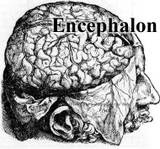Encephalon - 5th edition
 Welcome to the Fifth Edition of Encephalon, a neuroscience blog carnival.
Welcome to the Fifth Edition of Encephalon, a neuroscience blog carnival.Let's start with a topic of perennial interest: what really separates man from the animals? Neurontic presents one autistic's view of that distinction. Similar territory is covered in other posts from Neurontic, such as this one about that essential commonality across the animal kingdom - sex - and how modern neuropharmaceuticals may be altering sexual (and romantic?) experience. And then there's the flip-side: are there neurochemical benefits specific to unprotected sex?
If neurochemicals are your thing, you'll love The Story of NAAG. Cyberspace Rendezvous covers the possible source of the most important excitatory neurotransmitters - glutamate - in exquisite detail. Will it ever be possible to fully deconstruct the complicated machinery underlying neural computation?
The Neurophilosopher asks this question in a different way: to what extent will it be possible to reconstruct neural machinery with nanotechnology? The Neurophilosopher reviews the state of the art in nanomachinery, with a telling comparison to the complexity of potassium channel mechanics.
Coturnix's Blog Around the Clock takes the analysis of potassium channel mechanics a step farther: it's starting to look like voltage-gated potassium channels are not mere binary gates, with only simple on and off states. Instead, each ion channel may be capable of incredibly precise activity regulation - on the order of 1,000 different configurations - resulting in millions of different functional states.
Pure Pedantry connects this talk of potassium channels to the macroscale: some potassium channels may be critical for depression. As it turns out, mice without a TREK-1 potassium channel are "immune" to several established paradigms for inducing depression, and show other markers of non-depressed (or chemically anti-depressed) mice.
In an excellent post, Mind Hacks analyzes more macroscale issues of mental illness in the context of Philip K Dick's A Scanner Darkly (see also this post from the Neurophilosopher on the neural correlates of viewing rotoscope films, like the new film adaptation of A Scanner Darkly). Apparently the book was inspired partly by amphetamine use, and partly by Roger Sperry's work on split-brain patients.
Meanwhile, Thinking Meat takes a little swipe at such sci-fi views of the brain (i.e., the "brain as computer" metaphor) while introducing a new study on the role of nitric oxide in waking. Also, check out this post, an (appropriately) critical review of sex-differences research.
Along the same lines, the Mouse Trap has a tongue-in-cheek analysis of hemispheric processing asymmetries in males and females. There are several other nice posts from Sandy G, including this one about stage-like progressions in theory-of-mind development, as well as the principal components of personality that lead to "celebrity worship."
Finally, to end on a light note, here's a post at Omnibrain about some pernicious logical fallacies in computational neuroscience.
Retrospectacle will host the next edition of Encephalon on September 11th. Be sure to submit early!


2 Comments:
Many thanks Chris.
Absolutely! I was amazed at how well the posts related to one another.
Post a Comment
<< Home